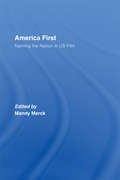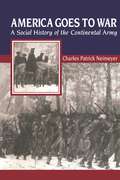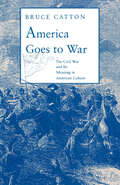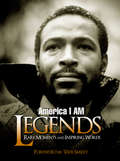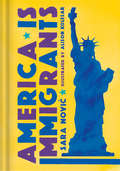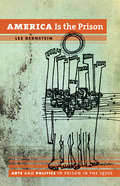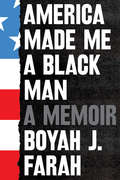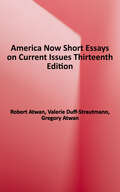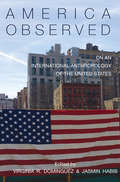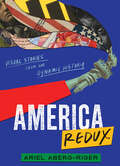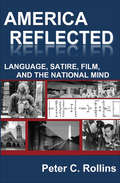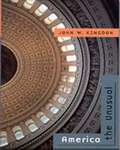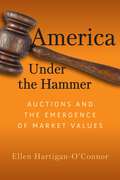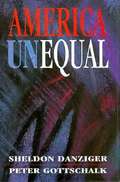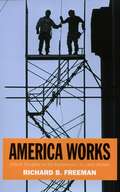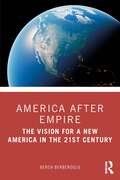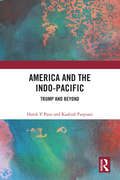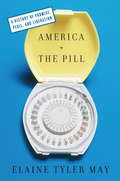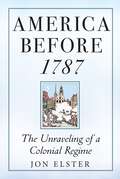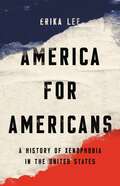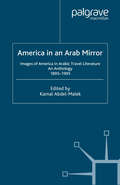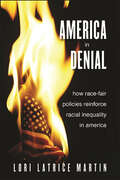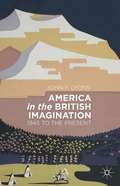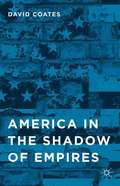- Table View
- List View
America First: Naming the Nation in US Film
by Mandy MerckAt a time when the expanded projection of US political, military, economic and cultural power draws intensified global concern, understanding how that country understands itself seems more important than ever. This collection of new critical essays tackles this old problem in a new way, by examining some of the hundreds of US films that announce themselves as titularly 'American'. From early travelogues to contemporary comedies, national nomination has been an abiding characteristic of American motion pictures, heading the work of Porter, Guy-Blaché, DeMille, Capra, Sternberg, Vidor, Minnelli and Mankiewicz. More recently, George Lucas, Paul Schrader, John Landis and Edward James Olmos have made their own contributions to Hollywood’s Americana. What does this national branding signify? Which versions of Americanism are valorized, and which marginalized or excluded? Out of which social and historical contexts do they emerge, and for and by whom are they constructed? Edited by Mandy Merck, the collection contains detailed analyses of such films as The Vanishing American, American Madness, An American in Paris, American Graffiti, American Gigolo, American Pie and many more.
America Goes to War: A Social History of the Continental Army (The American Social Experience #26)
by Charles Patrick NeimeyerA unique and revealing analysis of the diverse body that made up the Continental Army during the American Revolutionary War.One of the images Americans hold most dear is that of the drum-beating, fire-eating Yankee Doodle Dandy rebel, overpowering his British adversaries through sheer grit and determination. The myth of the classless, independence-minded farmer or hard-working artisan-turned-soldier is deeply ingrained in the national psyche.Charles Neimeyer here separates fact from fiction, revealing for the first time who really served in the army during the Revolution and why. His conclusions are startling. Because the army relied primarily on those not connected to the new American aristocracy, the African Americans, Irish, Germans, Native Americans, laborers-for-hire, and “free white men on the move” who served in the army were only rarely altruistic patriots driven by a vision of liberty and national unity.Bringing to light the true composition of the enlisted ranks, the relationships of African-Americans and of Native Americans to the army, and numerous acts of mutiny, desertion, and resistance against officers and government, Charles Patrick Neimeyer here provides the first comprehensive and historically accurate portrait of the Continental soldier.
America Goes to War: The Civil War and Its Meaning in American Culture
by Bruce CattonA fascinating study of the first modern war and its effect on American Culture.
America I am legends: Rare Moments And Inspiring Words
by Tavis SmileyWould America have been America without her Negro people?" - W. E. B. Du Bois America I AM: The African American Imprint, a national traveling museum exhibition, was conceived by award-winning broadcaster and bestselling author Tavis Smiley as a one-of-a-kind multi-media experience that chronicles the distinct history of African Americans. This beautifully conceived companion volume addresses the central theme of the exhibition, posed by W. E. B. Du Bois: "Would America have been America without her Negro people?" Through exceptional photographic images and penetrating words, America I AM Legends captures the dynamism of 78 legendary African Americans, highlighting the indelible imprint each has made on the United States and the world. A statement illuminating a unique aspect of each iconic figure- made by the legend or by someone carrying on their legacy today-portrays the vision and contribution of each subject. Whether black artistic genius, athletic excellence, political leadership, or the struggle to hold America true to its promise, each legend reminds us that America would be unrecognizable without its African American imprint. America I AM Legends takes us on an unforgettable journey to the heart of the American experience.
America Is Immigrants
by Sara NovicA gorgeously illustrated collection featuring inspiring immigrants from every country in the world, celebrating the incredible range of what it means to be an American This dazzling volume brings American immigrant stories to life in short biographies written by award-winning writer Sara Nović, with charming full-color illustrations by Alison Kolesar. At a time when public debate is focused on who belongs in America, this book honors the crucial contributions of our friends and neighbors who have chosen to make this country their home. Featured within are war heroes and fashion designers, Supreme Court justices and pop stars, athletes and civil rights leaders, as well as: • the doctors who saved Ronald Reagan’s life • the creators of iconic American products like Levi’s, Chevy cars and trucks, and Nathan’s Famous hot dogs • the scientists who contributed to the Manhattan Project • the architects behind landmarks of the American skyline like the World Financial Center in New York City, the Gateway Arch in St. Louis, and the Sears Tower in Chicago • Plus these familiar names from every walk of life: Madeleine Albright • Isabel Allende • Mario Andretti • Desi Arnaz • Isaac Asimov • George Balanchine • Sergey Brin • Gisele Bündchen • Willem de Kooning • Oscar de la Renta • Marlene Dietrich • Albert Einstein • Alfred Hitchcock • Arianna Huffington • Enrique Iglesias • Iman • Grace Jones • Henry Kissinger • Mila Kunis • Hedy Lamarr • Yo-Yo Ma • Miriam Makeba • Pedro Martínez • Joni Mitchell • Sidney Poitier • Wolfgang Puck • Rihanna • Knute Rockne • M. Night Shyamalan • Gene Simmons • Nikola Tesla • the von Trapps • Elie Wiesel • Anna Wintour
America Is the Prison: Arts and Politics in Prison in the 1970s
by Lee BernsteinIn the 1970s, while politicians and activists outside prisons debated the proper response to crime, incarcerated people helped shape those debates though a broad range of remarkable political and literary writings. Lee Bernstein explores the forces that sparked a dramatic "prison art renaissance," shedding light on how incarcerated people produced powerful works of writing, performance, and visual art. These included everything from George Jackson's revolutionary Soledad Brother to Miguel Pinero's acclaimed off-Broadway play and Hollywood film Short Eyes. An extraordinary range of prison programs--fine arts, theater, secondary education, and prisoner-run programs--allowed the voices of prisoners to influence the Black Arts Movement, the Nuyorican writers, "New Journalism," and political theater, among the most important aesthetic contributions of the decade. By the 1980s and '90s, prisoners' educational and artistic programs were scaled back or eliminated as the "war on crime" escalated. But by then these prisoners' words had crossed over the wall, helping many Americans to rethink the meaning of the walls themselves and, ultimately, the meaning of the society that produced them.
America Made Me a Black Man: A Memoir
by Boyah J. FarahA searing memoir of American racism from a Somalian-American who survived hardships in his birth country only to experience firsthand the dehumanization of Blacks in his adopted land, the United States.“No one told me about America.” Born in Somalia and raised in a valley among nomads, Boyah Farah grew up with a code of male bravado that helped him survive deprivation, disease, and civil war. Arriving in America, he believed that the code that had saved him would help him succeed in this new country. But instead of safety and freedom, Boyah found systemic racism, police brutality, and intense prejudice in all areas of life, including the workplace. He learned firsthand not only what it meant to be an African in America, but what it means to be African American. The code of masculinity that shaped generations of men in his family could not prepare Farah for the painful realities of life in the United States. Lyrical yet unsparing, America Made Me a Black Man is the first book-length examination of American racism from an African outsider’s perspective. With a singular poetic voice brimming with imagery, Boyah challenges us to face difficult truths about the destructive forces that threaten Black lives and attempts to heal a fracture in Black men’s identity.
America Now: Short Essays on Current Issues, Thirteenth Edition
by Robert AtwanAmerica Now makes it easy for you to bring brief, thought-provoking essays on contemporary topics into your classroom, with reliable pedagogy and an expert reader's knowledge of what works for students. As series editor for The Best American Essays, Robert Atwan constantly scours a wide range of publications, bringing to America Now an unrivaled focus on today’s best writing. Instructors tell us that their students want to respond to the essays in the book, and they praise the high-quality reading and writing instruction, critical thinking and reading questions, and model student essays that help them do so. Over half of the readings in America Now are new to this edition and published since 2018, making it truly a book for today's composition course.
America Observed: On an International Anthropology of the United States
by Virginia R. Dominguez Jasmin HabibThere is surprisingly little fieldwork done on the United States by anthropologists from abroad. America Observed fills that gap by bringing into greater focus empirical as well as theoretical implications of this phenomenon. Edited by Virginia Dominguez and Jasmin Habib, the essays collected here offer a critique of such an absence, exploring its likely reasons while also illustrating the advantages of studying fieldwork-based anthropological projects conducted by colleagues from outside the U.S. This volume contains an introduction written by the editors and fieldwork-based essays written by Helena Wulff, Jasmin Habib, Limor Darash, Ulf Hannerz, and Moshe Shokeid, and reflections on the broad issue written by Geoffrey White, Keiko Ikeda, and Jane Desmond. Suitable for introductory and mid-level anthropology courses, America Observed will also be useful for American Studies courses both in the U.S. and elsewhere.
America Redux: Visual Stories from Our Dynamic History
by Ariel Aberg-RigerA critical, unflinching cultural history and fierce beacon of hope for a better future, America Redux is a necessary and galvanizing read. What are the stories we tell ourselves about America? How do they shape our sense of history, cloud our perceptions, inspire us? America Redux explores the themes that create our shared sense of American identity and interrogates the myths we’ve been telling ourselves for centuries. With iconic American catchphrases as chapter titles, these twenty-one visual stories illuminate the astonishing, unexpected, sometimes darker sides of history that reverberate in our society to this very day—from the role of celebrity in immigration policy to the influence of one small group of white women on education to the effects of “progress” on housing and the environment, to the inspiring force of collective action and mutual aid across decades and among diverse groups. Fully illustrated with collaged archival photographs, maps, documents, graphic elements, and handwritten text, this book is a dazzling, immersive experience that jumps around in time and will make you view history in a whole different light.
America Reflected: Language, Satire, Film, and the National Mind
by Peter C. RollinsEclectic criticism and insightful observations from “one of the most respected cultural historians working today” (Ronald A. Wells, Professor of History Emeritus, Calvin College). “From cowboy philosopher Will Rogers to popular perceptions of two world wars and Vietnam, from the history of language to the language of film and television, Peter Rollins has devoted his career to exploring the intriguing ways in which the creative impulse both shapes and reflects American culture. His observations are fresh, illuminating and of enduring value.” —John E. O’Connor, co-founder/editor of Film & History: An Interdisciplinary Journal of Film and Television Studies“Examines the roles of language, satire, and film in reflecting the American consciousness through such diverse sources as Orestes Brownson, Benjamin Lee Whorf, Will Rogers, and Hollywood. Readers of America Reflected are in for a delightful voyage as they travel through American history and culture with Peter Rollins as their guide providing personal and scholarly insights into the shaping of the American mind.” —Ron Briley, editor of The Politics of Baseball: Essays on the Pastime and Power at Home and Abroad“Even those who have known and admired Peter Rollins’s acclaimed works will here find enlightening surprises. Epistemology, language theory, war’s polemics, filmed history, and an array of significant creators of American culture are all elegantly displayed. This book will make you a wiser person and charm you while it does it.” —John Shelton Lawrence, Emeritus Professor of Philosophy, Morningside College“Two decades ago I was privileged to work on a book, America Observed, with Alistair Cooke. Now we have America Reflected by Peter Rollins . . . Not only does Rollins make good observations about our lives and times, his reflections on a diverse set of subjects helps us to see the meanings of our observations.” —Ronald A. Wells, Professor of History Emeritus, Calvin College “Rollins gathers together glimpses of our shared worlds, so that we may observe their interconnections across media, genres, and time. From down-home values and front-porch philosophy, to tales of wars and chronicles of lives, the subjects considered here are all part of the stories we tell about ourselves and our social worlds.” —Cynthia J. Miller, President, Literature/Film Association
America The Unusual
by John W. KingdonKingdon explores how the American polity is different from that of other countries - particularly other Western democracies - examining just how this uniqueness came about. It invites both introductory and advanced students to appreciate the roots and limits of American exceptionalism, and to recognize the profound importance of current debates over the government's role in our everyday lives.
America Under the Hammer: Auctions and the Emergence of Market Values (Early American Studies)
by Ellen Hartigan-O'ConnorReveals how, through auctions, early Americans learned capitalismAs the first book-length study of auctions in early America, America Under the Hammer follows this ubiquitous but largely overlooked institution to reveal how, across the eighteenth and early nineteenth centuries, price became an accepted expression of value. From the earliest days of colonial conquest, auctions put Native land and human beings up for bidding alongside material goods, normalizing new economic practices that turned social relations into economic calculations and eventually became recognizable as nineteenth-century American capitalism.Starting in the eighteenth century, neighbors collectively turned speculative value into economic “facts” in the form of concrete prices for specific items, thereby establishing ideas about fair exchange in their communities. This consensus soon fractured: during the Revolutionary War, state governments auctioned loyalist property, weaponizing local group participation in pricing and distribution to punish political enemies. By the early nineteenth century, suspicion that auction outcomes were determined by manipulative auctioneers prompted politicians and satirists to police the boundaries of what counted as economic exchange and for whose benefit the economy operated. Women at auctions—as commodities, bidders, or beneficiaries—became a focal point for gendering economic value itself. By the 1830s, as abolitionists attacked the public sale of enslaved men, women, and children, auctions had enshrined a set of economic ideas—that any entity could be coded as property and priced through competition—that have become commonsense understandings all too seldom challenged.In contrast to histories focused on banks, currencies, or plantations, America Under the Hammer highlights an institution that integrated market, community, and household in ways that put gender, race, and social bonds at the center of ideas about economic worth. Women and men, enslaved and free, are active participants in this story rather than bystanders, and their labor, judgments, and bodies define the resulting contours of the American economy.
America Unequal
by Sheldon Danziger; Peter GottschalkAmerica Unequal challenges the view, emphasized in the Republicans' "Contract with America," that restraining government social spending and cutting welfare should be our top domestic priorities. Instead, it proposes a set of policies that would reduce poverty by supplementing the earnings of low-wage workers and increasing the employment prospects of the jobless. Such demand-side policies, are essential for correcting a labor market that has been increasingly unable to absorb less-skilled and less-experienced workers.
America Works: Thoughts on an Exceptional U.S. Labor Market
by Richard B. FreemanThe U.S. labor market is the most laissez faire of any developed nation, with a weak social safety net and little government regulation compared to Europe or Japan. Some economists point to this hands-off approach as the source of America’s low unemployment and high per-capita income. But the stagnant living standards and rising economic insecurity many Americans now face take some of the luster off the U.S. model. In America Works, noted economist Richard Freeman reveals how U.S. policies have created a labor market remarkable both for its dynamism and its disparities. America Works takes readers on a grand tour of America’s exceptional labor market, comparing the economic institutions and performance of the United States to the economies of Europe and other wealthy countries. The U.S. economy has an impressive track record when it comes to job creation and productivity growth, but it isn’t so good at reducing poverty or raising the wages of the average worker. Despite huge gains in productivity, most Americans are hardly better off than they were a generation ago. The median wage is actually lower now than in the early 1970s, and the poverty rate in 2005 was higher than in 1969. So why have the benefits of productivity growth been distributed so unevenly? One reason is that unions have been steadily declining in membership. In Europe, labor laws extend collective bargaining settlements to non-unionized firms. Because wage agreements in America only apply to firms where workers are unionized, American managers have discouraged unionization drives more aggressively. In addition, globalization and immigration have placed growing competitive pressure on American workers. And boards of directors appointed by CEOs have raised executive pay to astronomical levels. Freeman addresses these problems with a variety of proposals designed to maintain the vigor of the U.S. economy while spreading more of its benefits to working Americans. To maintain America’s global competitive edge, Freeman calls for increased R&D spending and financial incentives for students pursuing graduate studies in science and engineering. To improve corporate governance, he advocates licensing individuals who serve on corporate boards. Freeman also makes the case for fostering worker associations outside of the confines of traditional unions and for establishing a federal agency to promote profit-sharing and employee ownership. Assessing the performance of the U.S. job market in light of other developed countries’ recent history highlights the strengths and weaknesses of the free market model. Written with authoritative knowledge and incisive wit, America Works provides a compelling plan for how we can make markets work better for all Americans. A Volume in the Russell Sage Foundation's Centennial Series
America after Empire: The Vision for a New America in the 21st Century
by Berch BerberogluAfter the end of America’s longest (20-year) war in Afghanistan and Iraq that cost more than $6 trillion and nearly half a million lives, what does the future hold for America and the American people in the 21st century? In this timely and important book, Berch Berberoglu provides an eye-opening account of the history of the American Empire from its inception to the present, with prospects for its future. Examining the worldwide expansion of the American Empire over the course of its turbulent history in great detail, Berberoglu assesses America’s imperial legacy in a sober way, highlighting its failure to come to terms with the enormous cost of this adventure in imperial overreach. But Berberoglu sees light at the end of the long, dark tunnel, when the American people will awaken and lead the way to a new America after empire in the coming decades of the 21st century.
America and the Indo-Pacific: Trump and Beyond
by Harsh Pant Kashish ParpianiThis book offers an extensive account of Donald Trump’s foreign policy record in the Indo-Pacific region. Set against the backdrop of Trump’s policy of sustained US confrontation with China, it recounts his administration’s efforts to shore up America’s position with the Indo-Pacific strategy. It also reviews Trump’s record with allies and partners in the Indo-Pacific and the South Asian subregion in context of the ‘great power competition’ between China and the United States. Amidst the ongoing conversations on the declining currency of American internationalism, the volume showcases the seeming insularity of the Indo-Pacific region from forces that are informing an America in retreat. In noting Trump’s record to have been a consequential one, the authors also offer insights into the prospects for US policy continuity under Joe Biden. This timely book will be of great interest to scholars, teachers and students of politics and international relations, Asia studies, US-China studies, area studies, foreign policy, maritime studies, and world politics. It is a recommended read for all watchers of US foreign policy and the evolving US-China rivalry.
America and the Pill: A History of Promise, Peril, and Liberation
by Elaine Tyler MayIn 1960, the FDA approved the contraceptive commonly known as "the pill. ” Advocates, developers, and manufacturers believed that the convenient new drug would put an end to unwanted pregnancy, ensure happy marriages, and even eradicate poverty. But as renowned historian Elaine Tyler May reveals in America and the Pill, it was women who embraced it and created change. They used the pill to challenge the authority of doctors, pharmaceutical companies, and lawmakers. They demonstrated that the pill was about much more than family planning-it offered women control over their bodies and their lives. From little-known accounts of the early years to personal testimonies from young women today, May illuminates what the pill did and did not achieve during its half century on the market.
America as Second Creation: Technology and Narratives of New Beginnings
by David E. NyeAfter 1776, the former American colonies began to reimagine themselves as a unified, self-created community. Technologies had an important role in the resulting national narratives, and a few technologies assumed particular prominence. Among these were the axe, the mill, the canal, the railroad, and the irrigation dam. In this book David Nye explores the stories that clustered around these technologies. In doing so, he rediscovers an American story of origins, with America conceived as a second creation built in harmony with God's first creation. While mainstream Americans constructed technological foundation stories to explain their place in the New World, however, marginalized groups told other stories of destruction and loss. Native Americans protested the loss of their forests, fishermen resisted the construction of dams, and early environmentalists feared the exhaustionof resources. A water mill could be viewed as the kernel of a new community or as a new way to exploit labor. If passengers comprehended railways as part of a larger narrative about American expansion and progress, many farmers attacked railroad land grants. To explore these contradictions, Nye devotes alternating chapters to narratives of second creation and to narratives of those who rejected it. Nye draws on popular literature, speeches, advertisements, paintings, and many other media to create a history of American foundation stories. He shows how these stories were revised periodically, as social and economic conditions changed, without ever erasing the earlier stories entirely. The image of the isolated frontier family carving a homestead out of the wilderness with an axe persists to this day, alongside later images and narratives. In the book's conclusion, Nye considers the relation between these earlier stories and such later American developments as the conservation movement, narratives of environmental recovery, and the idealization of wilderness.
America before 1787: The Unraveling of a Colonial Regime
by Jon ElsterAn original account, drawing on both history and social science, of the causes and consequences of the American RevolutionWith America before 1787, Jon Elster offers the second volume of a projected trilogy that examines the emergence of constitutional politics in France and America. Here, he explores the increasingly uneasy relations between Britain and its American colonies and the social movements through which the thirteen colonies overcame their seemingly deep internal antagonisms.Elster documents the importance of the radical uncertainty about their opponents that characterized both British and American elites and reveals the often neglected force of enthusiasm, and of emotions more generally, in shaping beliefs and in motivating actions. He provides the first detailed examinations of &“divide and rule&” as a strategy used on both sides of the Atlantic and of the rise and fall of collective action movements among the Americans. Elster also explains how the gradual undermining in America of the British imperial system took its toll on transatlantic relations and describes how state governments and the American Confederation made crucial institutional decisions that informed and constrained the making of the Constitution.Drawing on a wide range of historical sources and on theories of modern social science, Elster brings together two fields of scholarship in innovative and original ways. The result is a unique synthesis that yields new insights into some of the most important events in modern history.
America for Americans: A History of Xenophobia in the United States
by Erika LeeAn award-winning historian reframes our continuing debate over immigration with a compelling history of xenophobia in the United States and its devastating impactThe United States is known as a nation of immigrants. But it is also a nation of xenophobia. In America for Americans, Erika Lee shows that an irrational fear, hatred, and hostility toward immigrants has been a defining feature of our nation from the colonial era to the Trump era. Benjamin Franklin ridiculed Germans for their "strange and foreign ways." Americans' anxiety over Irish Catholics turned xenophobia into a national political movement. Chinese immigrants were excluded, Japanese incarcerated, and Mexicans deported. Today, Americans fear Muslims, Latinos, and the so-called browning of America. Forcing us to confront this history, America for Americans explains how xenophobia works, why it has endured, and how it threatens America. It is a necessary corrective and spur to action for any concerned citizen.
America in An Arab Mirror: Images of America in Arabic Travel Literature: An Anthology
by K. Abdel-MalekThis distinguished anthology presents for the first time in English travel essays by Arabic writers who have visited America in the second half of the century. The view of America which emerges from these accounts is at once fascinating and illuminating, but never monolithic. The writers hail from a variety of viewpoints, regions, and backgrounds, so their descriptions of America differently engage and revise Arab pre-conceptions of Americans and the West. The country figures as everything from the unchanging Other, the very antithesis of the Arab self, to the seductive female, to the Other who is both praiseworthy and reprehensible.
America in Denial: How Race-Fair Policies Reinforce Racial Inequality in America (SUNY series in African American Studies)
by Lori Latrice MartinIn America in Denial Lori Latrice Martin examines the myth of a race-fair America by reviewing and offering alternatives to universal, race-neutral programs and policies as well as other allegedly race-neutral initiates. By considering policies and programs related to wealth, health, education, and criminal justice, while presenting themselves as race-neutral, Martin reveals that black scholars and politicians, in particular, seemingly capitulate and have become proponents of these programs and policies that perpetuate the myth of a race-fair America. This (mis)use provides cover for elected officials and presidential hopefuls needed to garner the support and authenticity required to increase public support for their initiatives. These issues must be unpacked and debunked, and the material and nonmaterial harm historically done to black people, and still felt today, must be acknowledged. The idea that programs available to all people will benefit black people is demonstratively untrue, and the alternatives presented in America in Denial will generate much-needed conversations.
America in the British Imagination
by John F. LyonsHow was American culture disseminated into Britain? Why did many British citizens embrace American customs? And what picture did they form of American society and politics? This engaging and wide-ranging history explores these and other questions about the U. S. 's cultural and political influence on British society in the post-World War II period.
America in the Shadow of Empires
by David CoatesThe focus of the book is the cost of empire, particularly the cost in the American case the internal burden of American global leadership. The book builds an argument about the propensity of external responsibilities to undermine the internal strength, raising the question of the link between weakening and the global spread of American power. "
